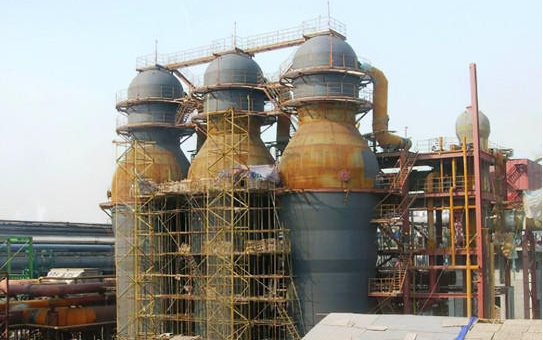- 23
- Oct
Blast furnace hot blast stove non-stop maintenance construction process and quality requirements
Blast furnace hot blast stove non-stop maintenance construction process and quality requirements
The hot blast stove maintenance masonry and spraying construction process are searched and compiled by the refractory brick manufacturer.

1. Features of non-stop masonry maintenance for hot blast stoves:
The construction is carried out in a state of non-stop production, and only one hot blast stove can be used at a time, and the others continue to work. When a hot blast stove is dismantled and repaired and put into production, the kiln will stop and the next hot blast stove will continue to be demolished, repaired, and put into production. Therefore, the hot blast stove non-stop masonry maintenance process is: removal, installation, masonry, oven, and production repeat until Repair of all hot blast stoves has been completed.
2. Förberedelse före murning av varmblåsugnen:
(1) The shell of the hot blast stove is installed in place, the welding is completed, and the welding seam inspection is qualified, and the acceptance is completed;
(2) Gallerpelaren och gallret har installerats och kontrollerats för att bekräfta att de uppfyller konstruktions- och konstruktionskraven.
(3) The welding of the flue outlet, hot air outlet, gas outlet, air outlet, temperature measurement, pressure measurement hole and short manhole pipe is completed, and the quality is confirmed to be qualified and the acceptance is completed;
(4) Ritningslinjemarkeringarna som mittlinje, höjd, mättecken och kontrollpunkter för den heta blästerkaminen är exakta och tydliga;
(5) The installation and welding of the anchors are completed, and the quality inspection is qualified and the acceptance is completed;
(6) The quantity, quality and material of refractory materials are qualified and stored properly and orderly after entering the site;
(7) Use various engineering equipment, appliances, etc. to pass the trial operation and enter the site.
3. Hot blast stove masonry construction process:
(1) Masonry construction process arrangement:
No. 1 hot blast stove masonry, hot blast main pipe masonry → new and old hot blast main pipe connection and masonry, new and old flue branch pipe connection and masonry → No. 2 hot blast stove masonry, new and old hot blast main pipe connection and masonry, new and old flue Branch pipe connection and masonry → No. 3 hot blast stove masonry, new and old hot blast main pipe connection and masonry, new and old flue branch pipe connection and masonry.
(2) Paint spray construction arrangement:
1) Spraying construction of the furnace shell below the “S” bend root: The grate should be used as the dividing line for spraying construction, the lower part of the grate should be sprayed with scaffolding, and the upper part of the grate should be sprayed with a rigid hanging plate. The spraying sequence here is from top to bottom.
2) Spraying on the upper part of “S” bend: The spraying sequence should be carried out in stages from bottom to top, and the hemispherical part shall be left for the last spraying.
3) Quality requirements for spray coating layer:
The spraying distance should be 1~1.2m, and the thickness of each spraying should be controlled at about 40~50mm.
If the thickness of the spray coating exceeds 50mm, it should be sprayed twice, and the interval between the two should not exceed the initial setting time of the spray coating.
Ytan på det sprutade skiktet ska vara slät och fri från sprickor, löshet, avskalning etc., och beläggningens ojämnhet bör inte vara större än 5 mm.
Sprutkonstruktionen ska ställas in i segmenterad position eller fogen i stilnätet. Olika avbrottsproblem bör uppstå under sprutningen. Avbrottet ska göras uppruggat. Innan sprutningen igen ska fogen fuktas med vatten innan sprutningen fortsätter.
After the spray coating layer is applied to a certain area, it should be leveled and adjusted accurately with radius gauges.
After the leveling treatment is completed, check the quality, thickness and radius of the spray coating layer and confirm that it meets the design requirements.
